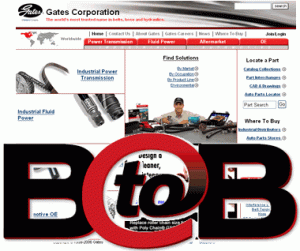by tradesmeninsights | Nov 14, 2013 | Public Relations, Social Marketing
Today we have a guest post from Rachel Kerstetter, our PR Engineer, about the evolution of social media and SEO.
 In our B2T niche, as well as in the general B2B market, we use the word “relevant” frequently.
In our B2T niche, as well as in the general B2B market, we use the word “relevant” frequently.
When it comes to B2T social media, quantity does not equal quality. Quality social media engagement can’t be measured in simple number of followers or likes. The relevance of those follows and likes is where we find the quality.
It can be hard to keep up with current SEO tactics that will land you on the first page of Google search results since the algorithms change every day, but as social media continues to grow, SEO is getting easier because it’s no longer optimizing for search engines that will land you on page one of Google.
Social engagement is becoming the new SEO. One of the many benefits of being involved in social media that I explain when we create social strategies is improving search visibility.
I was reading, “6 Reasons Social Media is Critical to Your SEO” on Social Media Today and Stephanie Frasco explained the concept so well when she wrote about the old SEO strategy of link building,
“Think about it – why did Google ever allow links to determine which websites ranked above all the others? The answer is simple: links were like “votes” for your website. The more votes you get, the better off you are. So SEO companies started building links (aka “votes”) manually[…]The idea behind links as a ranking factor is a very good idea, but since it’s become so easy to manipulate, Google has been forced to turn to social media channels which do the same thing but are much harder to manipulate. Link building was always about social proofing.”
The shift toward social search is an excellent opportunity to market more efficiently. Connecting with people (even in business-to-business social media, the decision-makers are still people) won’t have constantly changing algorithms because people have been communicating in similar ways basically forever. Social media is simply taking the natural, conversational form of communication that history shows taking place in the gathering places (think the Greek agora or the city coffee shop) and put it online, where it’s easier to be involved with the conversations that are relevant to you.
You can read the rest of Stephanie’s article here.
by tradesmeninsights | Aug 1, 2012 | Marketing Tips, Marketing Tools, Traditional Marketing
Guest Post
Sage Lewis is Founder and CEO of SageRock Inc., a digital marketing agency in business since 1999 and recognized as a Marketing Sherpa top ten U.S. search marketing company.
 You do a search on Google for your top-selling product and there you are in spot #1. Whew. Your listing is followed by your best distributor and then after him that new startup you signed on that knows how to market online, but has a website from 1998. Then the trade publications are interspersed in there, touting your product in their article but, sure enough, your competitor’s ad is all over the landing page. The paid search is filled mostly with competitors and Ebay folk selling parts without your permission.
You do a search on Google for your top-selling product and there you are in spot #1. Whew. Your listing is followed by your best distributor and then after him that new startup you signed on that knows how to market online, but has a website from 1998. Then the trade publications are interspersed in there, touting your product in their article but, sure enough, your competitor’s ad is all over the landing page. The paid search is filled mostly with competitors and Ebay folk selling parts without your permission.
Face it, this is a mess.
Your brand and products are being represented by everyone with a vague interest in them online. You want to control the marketing message, but how? Ideally people would come to you and localize for the distributor, but you can’t tell partners to disengage because it’s driving revenue for everybody. You talked about cookie cutter distribution sites, but those flop in Google. You can’t fund top distributor’s marketing the same as the guy who sells every competing line indiscriminately. Besides they all talk after 3 beers and you don’t need that hassle.
So, you do your own SEO and Paid Search and keep your head down, right? Wrong. There IS a solution to this madness. Here’s what you can do to fix this:
Create a system
What’s the ideal? Step one is defining the goal. What does page one on Google realistically need to look like when you visit? Now make it happen. How? That’s the system part.
Part one of the system:
Create a portal, a first place of contact for those selling product. It should be populated with everything you wish they inherently knew and thought you didn’t have to tell them (you do).
Shareable useful content:
- Approved photos
- Press releases on product and parts
- Video tutorials on selling and running demos
- Downloadable brochures and sales PDFs
- Recommended products by industry, price and other demo targeting
Tools and Resources:
- Training in effective SEO and PPC practices
- Google Analytics basics
- Localized targeting advice for PPC
- Local Page claim instructions
- SEO phrase recommendations for product and location (help everyone understand long vs. short tail)
- Ideal Phrases for distributors vs. corporate (and why they should comply for their best interest)
- Web design consultation and improvement tips and options
- Free software for managing digital marketing
Policy:
- Link back requirements
- Duplicate content restrictions
- Spam and other deal breakers
- Blog and social media policies
Launch the System
- An onsite launch / workshop is ideal.
- Explain and build excitement about the common goal (Discuss the master plan for online dominance).
- Show everyone how working together means increased revenue for those who comply.
- Bring in experts for your event.
Give funding incentives for those who follow the system
People won’t do it. Plain and simple. Money talks. Match investment. Give marketing dollars to those who use the portal and comply with the system. The smart ones will see the benefit and jump all over it.
Monitor and follow-up
- Use the tools in the portal to do your own digital marketing work.
- Monitor who’s doing what out there and reach out to the eyesores and the high achievers.
- Combat competitors who hijack product phrases. In paid, by contacting Google about policy and inorganic by creating content strategies that smack spam landing pages down.
- Encourage those complying to share success.
- Offer additional incentives for high achievers.
Is it a lot of work? Yes. Is it free of investment? No. Is it worth it in the long run? Of course. Take back your brand.
by tradesmeninsights | Jan 21, 2010 | Marketing Trends, Social Marketing
Small businesses must have been listening when it came to PSEO. According to data from WebVisible, search advertising has sharply increased in Q3 of ’09. According to a recent post on eMarketer.com, small business search spending by smaller companies was up 91% year over year. The average number of key words purchased was also up.

Other highlights from the study showed spending shifts among the key search engines with Google losing about 5% and Bing gaining almost 3%. Bing brought the small business owner the highest click through rates than any search engine. (Not a bad stat since they’ve only been around since June of this year.) Most click throughs went to the advertiser’s Web site and the fastest growing conversion action was video viewing.
Vertical Response cites that 45% of small businesses planned to up their spending next year.
So what are your plans?

by tradesmeninsights | Jun 16, 2009 | Marketing Trends
 I recently attended a webinar where the key speaker, Roy Young, President of MarketingProfs, shared key findings from the study on trends and spending strategies for B-to-B marketers. Highlights include:
I recently attended a webinar where the key speaker, Roy Young, President of MarketingProfs, shared key findings from the study on trends and spending strategies for B-to-B marketers. Highlights include:
- Reduced budgets
- Marketers are sharpening their focus
- New media is on the rise
- Emphasis is particularly strong for search marketing, webinars, emails and company web sites
- Digital and traditional tactics are being woven into an integrated marketing program
The implications are a trend toward the adoption of digital tactics, which started before the economic crisis, but have been accelerated by B-to-B marketers having to do more with less. Marketers have found that buyers want to be in control. The seller’s success depends on engagement and trust.
The study represented a broad range of B-to-B clients in both small, medium and large categories. While traditional tactics still remained the dominant player in 2007 and 2008, 2009 budget tactics now were including more of the social media mix.
To read the entire study, B-to-B marketing in 2009: Trends in Strategies and Spending

by tradesmeninsights | May 27, 2009 | Marketing Trends
 I know you’re convinced that your product or service is the best solution to a tradesman’s problem. According to a recent post in B2B marketing online, a new study from Enquiro Research shows that 99% of B-to-B buying is about CYA. If business buying is driven more by risk adversion, then you need to address those and take the risks out.
I know you’re convinced that your product or service is the best solution to a tradesman’s problem. According to a recent post in B2B marketing online, a new study from Enquiro Research shows that 99% of B-to-B buying is about CYA. If business buying is driven more by risk adversion, then you need to address those and take the risks out.
This puts a different light on how to approach these buyers to improve your conversion rates. Here’s a summary of some of their suggestions:
- Understand Business Buyer Risk. To improve conversion rates, it’s essential to understand the extent to which your company and its products or services may be perceived by your target buyers. From the eyes of the buyers, where do you stack up: are you a major player in the market or a new entry?
- Become an “Approved Vendor.” If you’re not the 800# gorilla in the market, you have an uphill battle. You could have the most brilliant marketing strategy, were able to get in to see the right people and even demo the product, but you don’t get the order. Reason – we got a better deal from our existing vendor or we went with an approved vendor. One way to address this is champion a teaser offer, e.g. 60-day trial period.
- Use Search Marketing to drive Word-of-Mouth. Enquiro research suggests that word-of-mouth can be hugely influential in the buying process, especially in those cases where the buyer has no previous experience in that product category. Search marketing is a powerful tool for getting your message in front of prospects.
- Personalized messages to different targets. Make each landing page, e-newsletter or offer as relevant as possible to the target. To increase conversions: match prospects with happy customers that came from similar risk profiles. Also consider linking to customer reviews.
What are you doing to improve conversions to sales?

 In our B2T niche, as well as in the general B2B market, we use the word “relevant” frequently.
In our B2T niche, as well as in the general B2B market, we use the word “relevant” frequently.


 I recently attended a webinar where the key speaker, Roy Young, President of MarketingProfs, shared key findings from the study on trends and spending strategies for B-to-B marketers. Highlights include:
I recently attended a webinar where the key speaker, Roy Young, President of MarketingProfs, shared key findings from the study on trends and spending strategies for B-to-B marketers. Highlights include: I know you’re convinced that your product or service is the best solution to a tradesman’s problem. According to a recent post in
I know you’re convinced that your product or service is the best solution to a tradesman’s problem. According to a recent post in